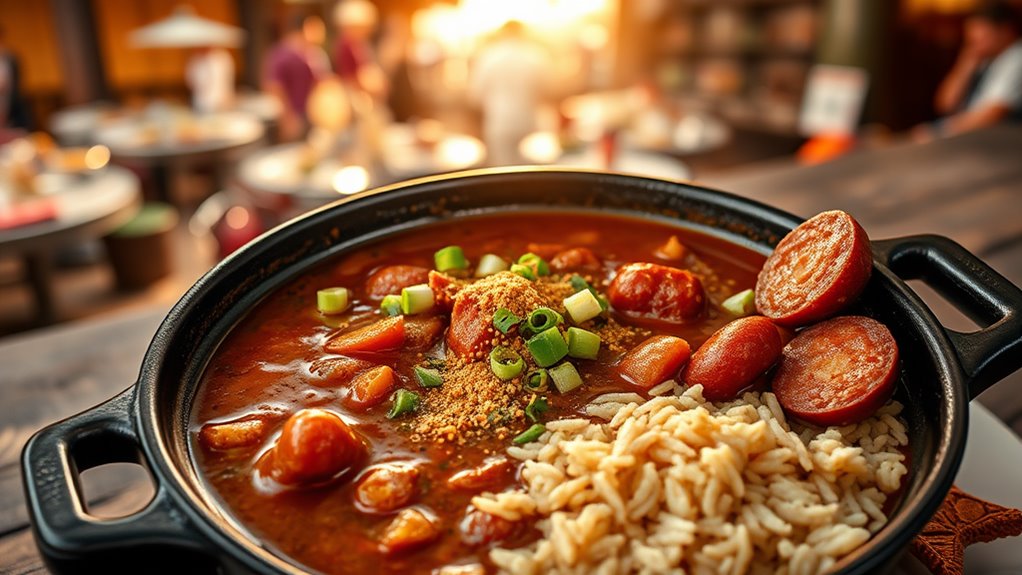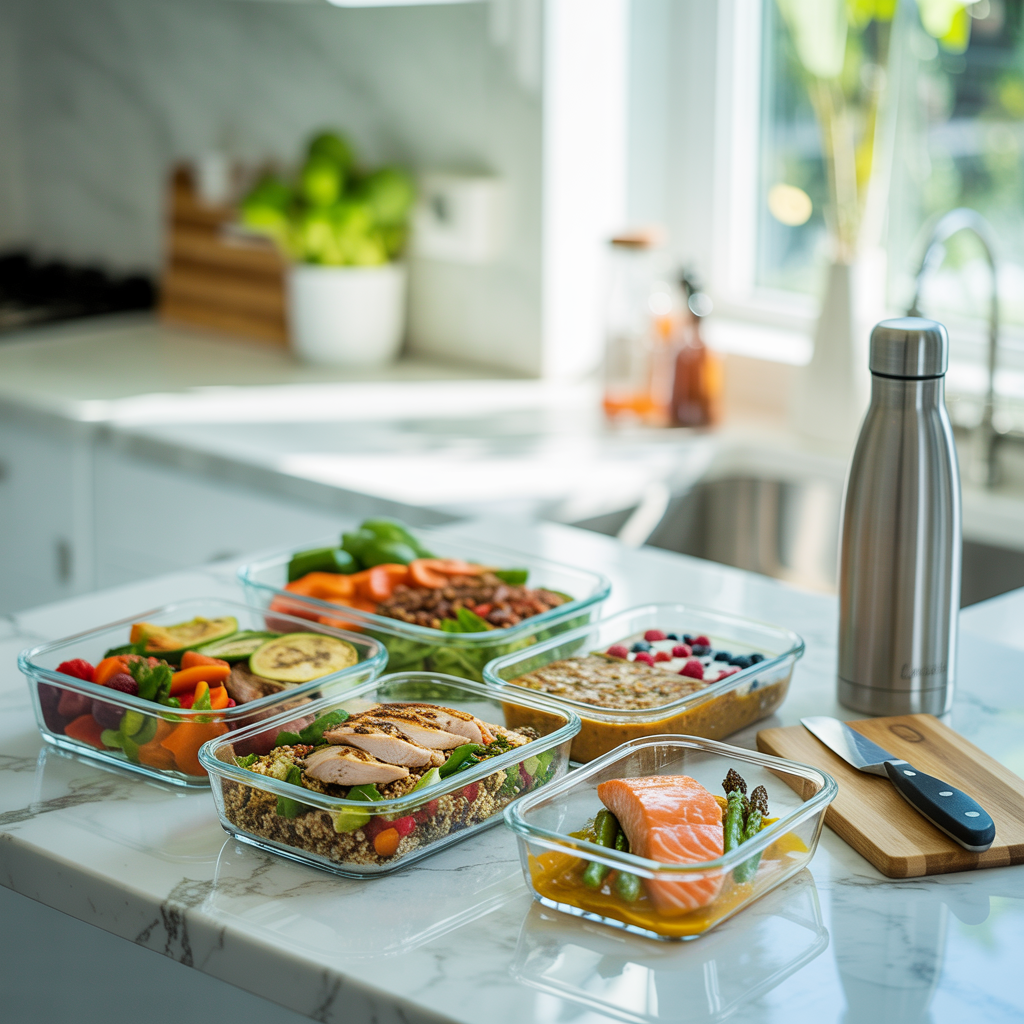Ready to make classic gumbo at home? Start with a dark roux by stirring equal parts oil and flour over medium heat until it’s chocolate-brown. Add the 삼위일체—onion, celery, and bell pepper—then mix in Andouille sausage, chicken, and spices like cayenne. Simmer with stock for hours, tossing in okra or filé powder for thickness. Stick around to uncover the rich history and more tips for perfecting this New Orleans staple!
역사
Gumbo, a beloved staple of Louisiana cuisine, traces its roots back to the early 18th century in the vibrant region of New Orleans. You’ll find its origins reflect a true melting pot, blending West African, French, Spanish, and Native American influences. Imagine the first documented mention in 1764, tied to an enslaved woman named Comba, showcasing its deep cultural ties.
Gumbo, a cherished gem of Louisiana cuisine, emerged in the early 18th century amidst the lively streets of New Orleans.
당신이 탐험하면서 gumbo’s history, notice how it embodies Louisiana’s diversity with contributions like okra from West Africa and filé powder from the Choctaw. Early versions of this iconic dish often lacked a roux base, incorporating a variety of ingredients like chicken, ham, and seafood lacked roux base. Over time, gumbo evolved in home kitchens, slowly combining African stews with French soups combining African stews. This evolution highlights gumbo’s adaptability, as it absorbed flavors from various immigrant groups over centuries absorbed flavors. Its popularity surged in the 1970s, notably through its presence on the U.S. Senate menu U.S. Senate menu.
By the mid-19th century, it became synonymous with New Orleans, symbolizing resilience and community. You can’t miss its rise as a cultural icon, later declared Louisiana’s official state dish in 2004.
레시피
Gumbo is a beloved dish rooted in the rich culinary traditions of Louisiana, embodying the diverse cultural influences of Cajun and Creole cuisines.
이것 classic recipe focuses on a hearty chicken and Andouille sausage gumbo, utilizing a dark roux for deep, nutty flavor and the Holy Trinity of vegetables as its aromatic base.
그것은 labor of love 저것 requires patience, especially when crafting the roux, but the result is a soul-warming stew perfect for gatherings or a cozy family meal.
Whether you’re a 노련한 요리사 또는 first-timer, this recipe is designed to guide you through the process with straightforward steps.
You’ll build layers of flavor starting with the roux, incorporating homemade stock if possible, and finishing with traditional accompaniments 좋다 white rice.
Adjust the spice level to your preference and feel free to experiment with proteins based on what’s available or your dietary needs.
The dark roux, often cooked to a chocolate brown, is essential for authentic gumbo flavor and serves as the foundation for thickening the stew with nutty depth.
재료:
- 1 cup vegetable oil or lard
- 다용도 밀가루 1컵
- 큰 양파 1개, 다진 것
- 2 celery stalks, diced
- 1 green bell pepper, diced
- 다진 마늘 3쪽
- 1 pound Andouille sausage, sliced into rounds
- 1.5 pounds boneless, skinless chicken thighs, cut into bite-sized pieces
- 8 cups chicken stock, preferably homemade
- 2 bay leaves
- 말린 타임 1티스푼
- 1 teaspoon cayenne pepper (adjust to taste)
- 1 tablespoon Cajun seasoning (check for salt content)
- 소금과 검은 후추 (취향에 따라)
- 1 teaspoon filé powder (optional)
- Cooked white rice, for serving
- Chopped green onions or parsley, for garnish
시작하다 making the roux in a large, heavy-bottomed pot or Dutch oven over medium heat.
Combine the vegetable oil and flour, 끊임없이 저어주다 with a wooden spoon to prevent burning.
Cook for 30-45 minutes, or until the roux reaches a dark chocolate brown color, being careful not to let it scorch—if it smells burnt, start over.
Once the desired color is achieved, immediately add the diced onion, celery, bell pepper, and garlic (the Holy Trinity plus garlic) to stop the cooking process, stirring to coat the vegetables in the roux.
Cook for 5-7 minutes until the vegetables soften.
Next, add the sliced Andouille sausage and chicken pieces to the pot, stirring to combine with the roux and vegetables.
Pour in the chicken stock slowly, stirring to incorporate and prevent lumps.
Add the bay leaves, thyme, cayenne pepper, Cajun seasoning, salt, and black pepper.
Bring the mixture to a boil, then reduce to a simmer.
Cover and cook for 1.5-2 hours, stirring occasionally, until the chicken is tender and the flavors meld.
If using filé powder, stir it in during the last 5 minutes of cooking, off the heat, to avoid a stringy texture.
Remove the bay leaves before serving.
Serve hot over white rice, garnished with green onions or parsley.
A few extra tips can elevate your gumbo experience.
Be patient with the roux—it’s the foundation of the dish, and rushing it can lead to a burnt or underwhelming base; keep a close eye and stir continuously.
Using a heavy-bottomed pot, such as cast iron, is crucial to ensure even heating and prevent scorching during the long roux-making process.
Remember that the longer you cook the roux, the more flavor it develops, but it will lose thickening power as the flour proteins break down.
If you’re new to filé powder, use it sparingly as it can overpower the dish, and never boil the gumbo after adding it.
For a thicker stew, consider adding okra during the last 30 minutes of cooking, ensuring it’s well-cooked to minimize sliminess.
Keep in mind that authentic gumbo typically includes around 15 distinct ingredients to achieve its complex flavor profile complex flavor profile.
Finally, gumbo often tastes even better the next day as the flavors continue to develop, so don’t hesitate to make it ahead of time.
요리 단계
Let’s get started on cooking classic gumbo by first preparing the roux, whisking fat and flour until you’ve got that rich, dark color. Next, toss in the holy trinity of onion, celery, and bell pepper, then add your sausage and seafood at the right times while simmering with okra to build those deep flavors. Don’t forget to adjust the seasoning carefully throughout to make sure every bite’s just right! Remember, achieving a deep chocolate brown roux is essential for authentic gumbo flavor, taking patience and constant stirring over low heat. For the best results, consider making a homemade stock in advance to add unparalleled depth and complexity to your gumbo.
Step 1. Prepare the Roux
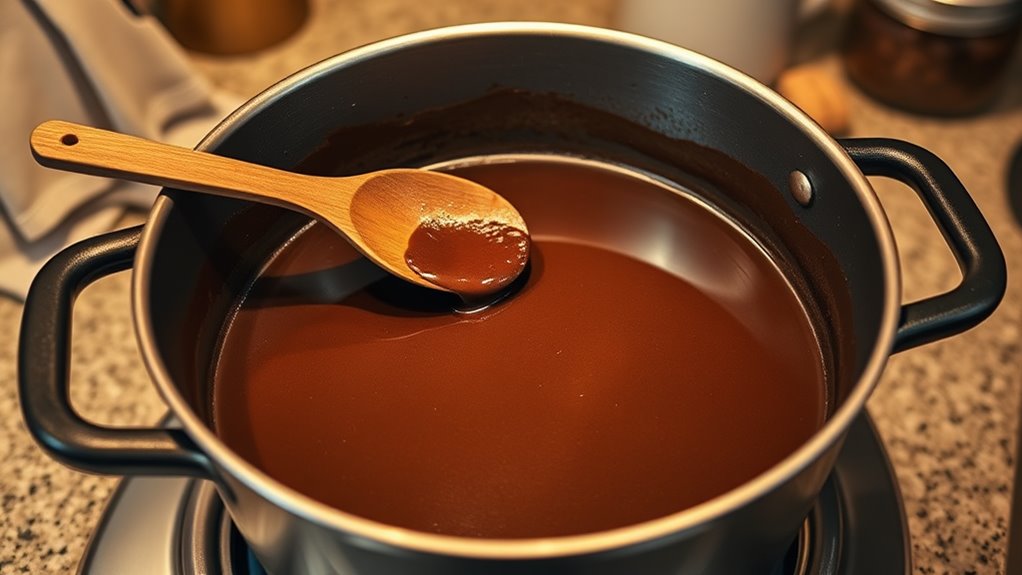
Dive right into the heart of gumbo by preparing the roux, an essential base that sets the tone for flavor and texture.
Grab a heavy-bottomed pot, like a cast iron skillet or Dutch oven, and heat equal parts of a neutral oil, such as canola, over medium heat.
Slowly whisk in flour until smooth, ensuring no lumps form.
Constant gentle stirring is crucial to achieve the perfect roux without burning it 준비하는 동안.
Stir constantly with a wooden spoon or spatula in a figure-eight pattern to prevent burning.
Watch the roux transform from white to a deep, chocolate-brown color over 20-45 minutes.
Lower the heat if needed to avoid scorching.
You’re aiming for a nutty, toasted aroma and a rich hue, signaling it’s ready for the next steps.
Remember, the darker the roux, the thinner it becomes, but it adds an unparalleled depth of flavor to your gumbo with its nutty taste.
Add Holy Trinity Vegetables
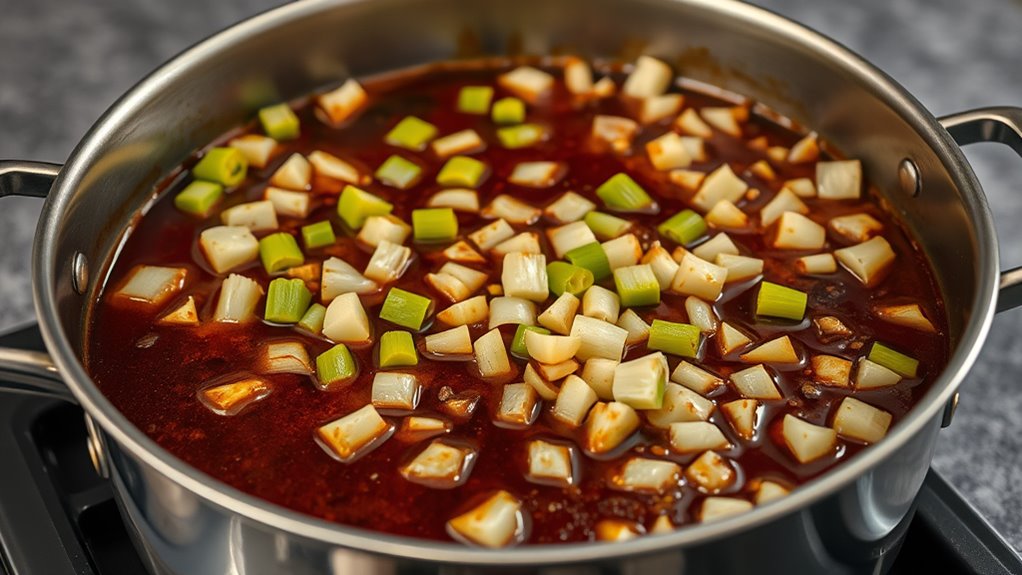
Now that your roux has reached that rich, chocolate-brown hue, it’s time to build on that foundation with the Holy Trinity vegetables.
Grab your chopped onion, green bell pepper, and celery, ideally in a 2:1:1 ratio, though equal parts work too.
Make sure they’re diced evenly for consistent cooking—peel the onion, deseed the pepper, and trim the celery beforehand.
Add these veggies to the hot roux over medium heat, 가끔씩 저어주면서.
You’re aiming to sweat and sauté them until they’re soft and translucent, which takes about 5-12 minutes.
This aromatic base sets the stage for your gumbo’s deep flavor.
If you’re using garlic, toss it in after the Trinity softens to avoid burning.
This trio, rooted in Cajun and Creole traditions, reflects South Louisiana’s cultural influence.
Known as the Cajun Trinity, this combination is essential for creating the authentic taste of Louisiana dishes like gumbo and jambalaya, highlighting regional settlers’ cuisine.
The Holy Trinity, adapted from the French mirepoix, showcases bell peppers’ prominence due to their availability in Louisiana’s unique environment.
The term Holy Trinity, first attested in 1981, nods to the Christian doctrine allusion in its naming.
Step 3. Incorporate Sausage and Seafood
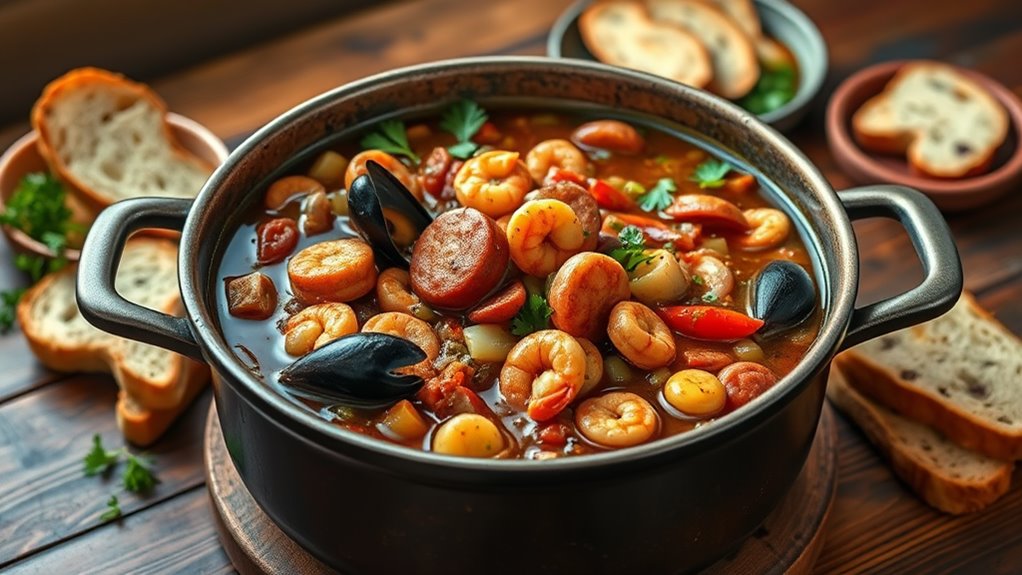
After softening the Holy Trinity vegetables in your roux, it’s time to layer in the bold flavors of sausage.
Grab some Andouille, the traditional choice for its smoky kick, or use kielbasa if you can’t find it.
Slice it into ¼ to ½-inch rounds, then brown it in the pot to render fat and boost flavor.
Set it aside on a plate, and don’t worry—since it’s pre-cooked, you’ll add it back later with the broth to meld those tastes.
지금, prep your seafood like shrimp, crab, or oysters.
Peel and devein shrimp, keeping shells for stock if you’d like.
Add these delicate ingredients only in the last 5-15 minutes, ensuring they don’t overcook and turn tough.
Remember, using shells from shrimp or crab can significantly enhance your stock with added depth.
For an extra layer of authenticity, consider adding gumbo file ground sassafras leaves at the end to thicken and flavor the dish.
Step 4. Simmer With Okra
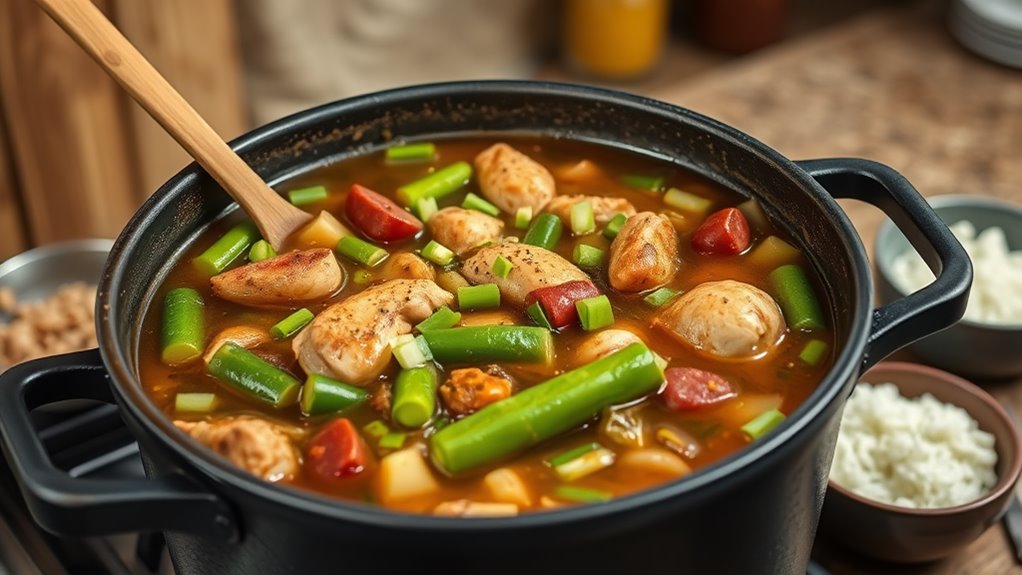
Bring your gumbo to the next level by adding okra, 아 핵심 성분 that thickens and defines the dish with its unique texture.
After incorporating your sausage and seafood, toss in the prepared okra—washed, trimmed, and sliced into uniform rounds.
Add it during the main simmering stage, right after the roux and aromatics blend with the stock.
Let your gumbo simmer gently for 15 minutes to over an hour, stirring occasionally to prevent sticking.
You’ll notice the okra tenderizing and breaking down, its mucilage thickening the stew beautifully.
Keep the pot uncovered or partially covered to control the consistency.
This step honors the historical roots of gumbo, as okra’s name and use trace back to West African origins.
Watch as this traditional ingredient transforms your gumbo, giving it that signature body and depth.
Okra not only thickens but also adds a vibrant color and flavor to your stew, enhancing its overall appeal.
Okra’s natural mucilage acts as a thickening agent in stews, making it indispensable for authentic gumbo recipes.
Step 5. Adjust Seasoning Carefully

Dive into the art of seasoning your gumbo with precision to guarantee every spoonful bursts with flavor.
As you cook, taste and adjust at each stage, layering salt, black pepper, cayenne, and Creole seasoning for depth.
Don’t wait until the end—seasoning throughout prevents blandness or overdoing it.
Near the finish, check salt levels, especially if using pre-salted ingredients like andouille or Cajun blends.
Add heat with cayenne or hot sauce, noting that cayenne’s kick fades over time.
Toss seafood with Creole seasoning before adding, and stir in fresh parsley or green onions for brightness.
If using filé powder, sprinkle it at the table to avoid stringiness, and remember that the holy trinity base provides essential aromatic depth to complement your seasoning.
Balance flavors by considering the roux’s richness, as a caramel-colored roux adds a nutty depth to your dish.
Taste one last time, ensuring every bite’s just right.
마지막 생각
While crafting a classic gumbo can be a labor of love, it’s a rewarding journey that brings together diverse flavors and cultural heritage in every bowl.
You’ve learned the importance of a well-made roux, the depth of the 삼위일체, and the patience needed for simmering.
Don’t rush—let those flavors meld over hours.
Take your time with the roux to ensure it reaches that perfect dark golden-brown color without burning.
Remember, gumbo’s versatility allows for endless variations, so feel free to experiment with ingredients like seafood or chicken.
자주 묻는 질문
What Are Common Gumbo Variations?
Hey, you’re curious about common gumbo variations, right?
Delve into Creole gumbo with tomatoes and shellfish like shrimp or crab, often using a lighter roux.
Then, try Cajun gumbo, featuring a dark roux, chicken, and sausage, usually without tomatoes.
Don’t forget protein mixes like seafood with meat or vegetarian gumbo z’herbes.
Experiment with thickeners too—roux, okra, or filé powder.
Mix it up and find your favorite style!
Can Gumbo Be Made Vegetarian?
Hey, you can absolutely make gumbo vegetarian and still keep those bold, traditional flavors!
Start with the holy trinity—onion, celery, bell pepper—and whip up a roux for depth.
Swap meat broth for vegetable stock, and toss in hearty veggies like mushrooms or beans for substance.
Add smoked paprika or liquid smoke for that smoky kick.
Serve it over rice, and you’ve got a delicious, meat-free gumbo!
How to Store Leftover Gumbo?
Wondering how to store leftover gumbo? You’ve gotta act fast!
Cool it to room temperature within two hours, or one if it’s super hot outside.
Spread it in shallow pans for quicker cooling, then pop it into airtight containers.
Refrigerate at 40°F or below for 3-4 days, or freeze for 3-6 months.
Label with the date, and you’re set to enjoy it later without worry!
What Drinks Pair With Gumbo?
Hey, wondering what drinks pair with gumbo? You’ve got plenty of options!
노력하다 off-dry white wines like Chenin Blanc to balance spicy heat, or a low-tannin red like Cru Beaujolais for meaty versions.
Beer’s a classic—grab a crisp lager or malty Bock for spice.
For cocktails, sip a crisp Gin Daisy or a bold Sazerac.
Match your drink’s body and flavor to your gumbo’s richness and heat!
Is Gumbo Gluten-Free by Default?
Hey, you’re wondering if gumbo is gluten-free by default, right? Well, it’s not. Traditional gumbo often uses a roux made with wheat flour, which contains gluten. Plus, ingredients like sausage or broth might sneak in gluten too. Don’t worry, though! You can make it gluten-free by swapping the roux for a gluten-free flour or using natural thickeners like okra or filé powder. Just check every label carefully!
참고문헌
- https://guidryscajunfoods.com/the-history-of-gumbo
- https://pelicanstateofmind.com/louisiana-love/original-melting-pot-louisianas-history-of-gumbo/
- https://randazzokingcake.com/blog/the-ultimate-guide-to-gumbo
- https://en.wikipedia.org/wiki/Gumbo
- https://www.southernfoodways.org/interview/a-short-history-of-gumbo/
- https://jpattirestaurant.com/the-secret-history-of-gumbo/
- https://www.bigeasy.com/news/the-rich-history-of-gumbo-a-culinary-icon-of-louisiana
- https://www.explorelouisiana.com/articles/inside-scoop-louisiana-gumbo
- https://www.foodandwine.com/what-is-gumbo-11687877
- https://infinetaste.com/the-secret-to-the-perfect-roux/
- https://culinarybackstreets.com/cities-category/new-orleans/2022/roux-the-day-how-to-make-the-humble-base-of-louisiana-cuisine/
- https://www.thespeckledpalate.com/how-to-make-roux-for-gumbo/
- https://www.themeatplate.com/gumbo-ingredients-list-the-ultimate-guide/
- https://www.gumbopages.com/food/ingred.html
- https://www.chilipeppermadness.com/recipes/how-to-make-a-roux/
- https://www.billyparisi.com/gumbo-recipe/
- https://www.mississippivegan.com/vegan-gumbo
- https://thought4food.life/carolina-gumbo-zherbs/
- https://laurenfromscratch.com/gumbo-roux/
- https://www.gumbopages.com/food/gumbo.html

